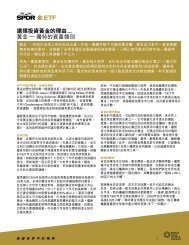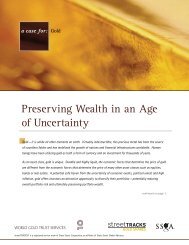You also want an ePaper? Increase the reach of your titles
YUMPU automatically turns print PDFs into web optimized ePapers that Google loves.
As previously discussed, gold’s benefits are even more evidentat the portfolio level when seen in conjunction with other assets.We analysed assets typically held by Japanese pension fundsand compared the performance of two portfolios, 19 one whichincluded a 5% allocation to gold, and one with no allocation togold. 20 Further, we considered two cases: the first one from theperspective of a Japanese investor holding gold in yen terms,and the second where the investor holds gold in US-dollar terms(i.e., by hedging the yen-US$ foreign-exchange exposure).Chart 7 shows the difference between the portfolio returnswith and without gold during tail-risk events. Similar to resultsobtained for Western investors, Japanese investors generallybenefitted from holding gold in their portfolios, either byreducing losses or increasing gains. The results show that a 5%allocation to gold in yen terms mitigated losses during all tailevents except during the Trust Fund Bureau shock. Japaneseinvestors would have saved a cumulative 2.3% over the ninetail-risk events under consideration. For investors currencyhedging gold (and holding it in US dollar terms), the collectiveloss reduction rose to 3.6%, despite the fact that the portfoliowith gold underperformed during the Trust Fund Bureau shockand the bursting of the Dot-com bubble. The underperformanceduring the Dot-com bubble was due to the fact that the shockwas primarily limited to the technology industry, and gold tendsto benefit more in periods of broad-reaching, systemic events.The reason the portfolio holding gold in yen terms outperformedwas a by-product of a strengthening yen. During that period,the rate differential between the US and Japan mitigated thepositive effect of the gold allocation in US dollar terms.The study shows that during past tail-risk events even a small5% gold allocation in a portfolio would have mitigated lossesand its effect would, on average, have been even greater wheregold was held in US dollars. Interestingly, despite the fact thatas an individual asset, gold may not have performed so stronglyin yen terms, when analysed as part of a portfolio it clearlydemonstrates that it can play a role in hedging tail-risk events.Thus, whether in yen or US-dollar terms, gold can benefitinvestors during periods of systemic risk.Chart 7: Improvement in portfolio performance from a 5% gold allocation*%1.41.21.00.80.60.40.20-0.2BlackMondayNikkeicrashLTCMcrisisTrust fundbureauDot-combubbleVaR shockSubprimeshockLehmanshockEarthquakeand tsunami<strong>Gold</strong> with no currency hedge<strong>Gold</strong> with currency hedge*Black Monday: October 1987, Nikkei crash: February 1990 – September 1990, LTCM: August 1998, Trust Fund Bureau: December 1998 – February 1999,Dot-com bubble: April 2000, VaR shock: July 2003 – August 2003, Subprime: August 2007, Lehman: October 2008 – January 2009,Earthquake and tsunami: March 2011.Source: Bloomberg, Citigroup, Nomura, World <strong>Gold</strong> Council19 For our analysis, we created a typical portfolio, taking as our point of reference the average asset allocation held by Japanese pension funds at the time, asdetailed by the Japanese Pension Fund Association.20 For the hypothetical portfolio, the 5% gold allocation was made as a substitution, replacing in the average portfolio of the time 1% Japanese bonds,2% Japanese equity, 1% global bonds, and 1% global equity. Optimal allocation to gold is 4.9% for a conservative portfolio as discussed inOptimal allocation to gold for Japanese investors, July 2012.<strong>Gold</strong> <strong>Investor</strong> | Risk management and capital preservation










